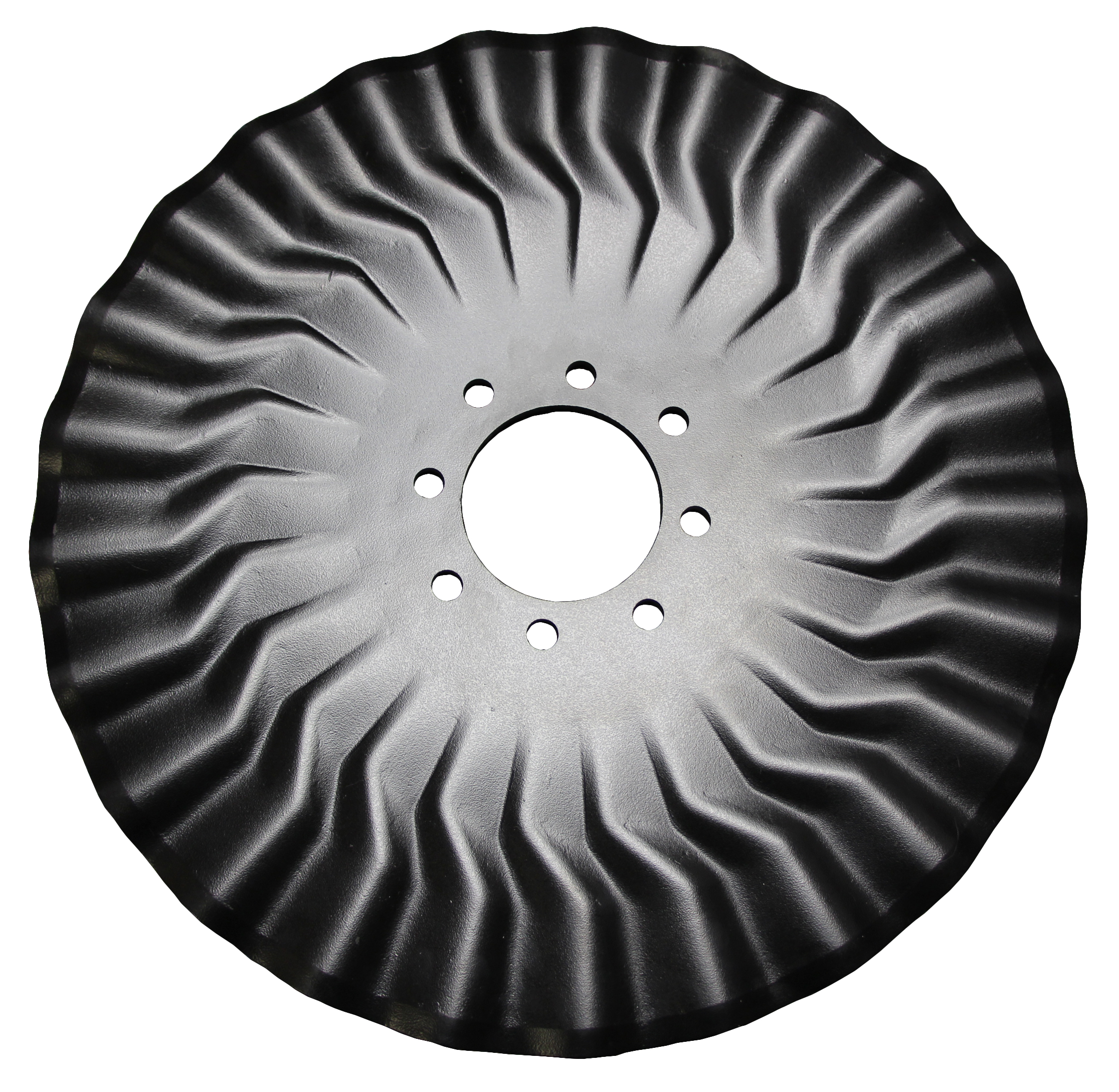Putting the right cut into the soil has been the focus of farmers looking for efficient seed placement.
Englishman Jethro Tull, according to Britannica, perfected a horse-drawn seed drill in 1701 that economically sowed the seeds in neat rows, as noted on his father’s farm in Oxfordshire. The advancement was a major change from scattering seeds by hand. He was also a developer of a horse-drawn hoe and other cultivation tools.
Tull’s success led to the publication of “The New Horse Hoeing Husbandry: Or an Essay on the Principles of Tillage and Vegetation” in 1733, according to Cornell University. Tull’s methods were eventually adopted by large landowners and laid the basis for modern and efficient British farming, Britannica noted.
Extensive research
Today’s planting experts depend on teams of engineers with extensive research and farmer input.
Pictured above is a coulter that was agronomically designed to replace the typical smooth coulters used on fertilizer toolbars. Farmers wanted ways to plant seeds deeper and allow for placement of fertilizer and other chemical products. This coulter allows a blade trench designed to close easier and seal better. (Photo courtesy of ShieldAg, Hutchinson, Kansas.)
“We have developed narrow kerf opener designs for minimal soil disturbance all while ensuring the seed is placed at the bottom of the furrow,” said Matt Hornung, with CrustBuster/Speed King Inc., of Spearville, Kansas. “We do not believe in coulters. We want to slice through residue with our lead blade, place the seed and close the furrow with minimal disturbance.”
Better and stronger lead blade cutting designs have been used with counter sunk rivets, he said. That design keeps the inside of the blade smooth and allows for longer service life since a farmer can shim the blade in farther, Hornung said.
For farmers who incorporate cover crops, the company’s Wobble Slot Meter accurately meters a large array of seed sizes and shapes, Hornung said. Additionally, multiple boxes can be used if a farmer wants to separately meter seed types and/or add fertilizer, he added.
Doug Jennings, a product manager with Great Plains Manufacturing, Salina, Kansas, said his company has been adapting and integrating agronomically sound practices since the company’s inception. The adaptation of the “Turbo Blade” in the mid 1990s, for example, has been becoming a standard in the industry because of the aggressive soil- and residue-cutting characteristics.
“This provides the ultimately tilled zone for the double disc blades to preciously place the seed,” Jennings said. “The effect of seed firming devices has led to a more consistent seed placement and improved seed to soil contact.”
The Turbo Blade design continues to be the foundation of Great Plains’ vertical and hybrid tillage units today, he said.
Innovation pays off
Hornung said on-the-go individual row unit hydraulic down force adjustments and sensing systems have been impressive along with variable rate seeding and row or section shut-off designs.
Jennings said the agricultural industry’s adaptation of global positioning technologies allows today’s producer to preciously apply and record all aspects of the production process while increasing efficiencies to levels that 20 years ago were only a dream. Another positive impact of the technology is reduced operator fatigue and improved safety.
Planting through stubble
The industry has also responded to producer needs of planting through stubble, Hornung said. The proven value and multiple benefits of leaving stubble and residue undisturbed on the ground makes sense.
“The stubble and residue you leave is money in the bank that will be used in your current and future crops,” he said. “It will be used for everything from erosion, organic matter, weed suppression, water infiltration, nutrient cycling, food for your beneficial microbes and fungi, etc.”
Jennings said the biggest drivers to no-till reduced tillage have been moisture conservation and improving soil health.
“Over the years we have learned through continual research that resetting soil profiles (removing density and compaction layers) is one of the fastest ways to improve water movement and root development as well as provide an environment for organic activity to prosper,” Jennings said. “Vertical tillage is one the best practices to manage residue while not harming soil structures and providing the ultimate seedbed for reduced tillage.”
What’s next?
Hornung is bullish on innovation for planting and seeding equipment. Seed monitoring technology for drills will continue to improve, he said, allowing drills to be used for a wider range of crops that traditionally would require a planter.
Equipment will continue to improve in planting into stall stubble or stalks in a variety of conditions, Hornung said. Using technology and sensors on implements and in the field to measure a variety of soil parameters could be used to place the seed at the ideal depth, at the ideal varied rate, with the ideal nutrients and at the ideal spacing in the row and between rows, he added.
“I believe soil health and how our crops are grown will take center stage in the coming years,” Hornung said.
Jennings believes the next innovations will start with the producer. He said, “The ag producer today continues to investigate, learn and adapt to environment around them to better understand the processes that can best improve their operation.”
Tull would be amazed and not surprised how far we have come.
Dave Bergmeier can be reached at 620-227-1822 or [email protected].




